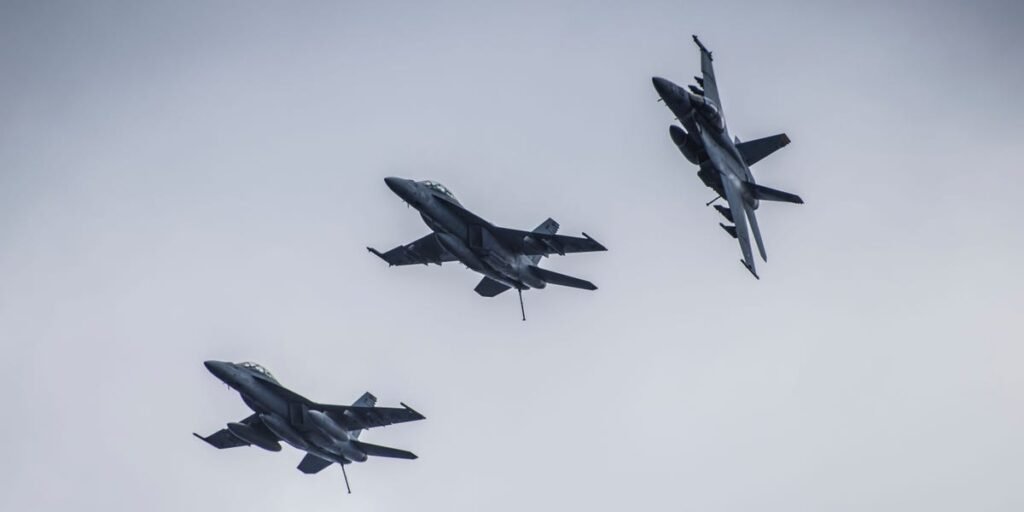US Navy fighter aircraft have been spotted in the Pacific carrying an air-launched version of a powerful ship-fired interceptor missile that only recently debuted in combat.
American warships fighting in the Middle East have fired the Standard Missile 6, or SM-6, to intercept munitions launched by the Iran-backed Houthi rebels, using it in a surface-to-air role.
But it appears to be getting a new role as a long-range air-to-air missile, a potentially significant development that could fill a crucial capability gap if the US went to war with China. A US Navy spokesperson told Naval News that “the SM-6 Air Launched Configuration (ALC) was developed as part of the SM-6 family of missiles and is operationally deployed in the Navy today.”
Multiple F/A-18E Super Hornets have been spotted in recent days carrying the SM-6 variant aboard the Nimitz-class aircraft carrier USS Carl Vinson and on the tarmac at Hawaii’s Joint Base Pearl Harbor-Hickam during the Rim of the Pacific Exercise, which boasts the world’s largest international maritime warfare drills.
The ship-launched SM-6, also known as the RIM-174 Standard Extended Range Active Missile and part of the Navy’s advanced Aegis Combat system, is a three-in-one extended-range weapon capable of anti-air and anti-surface warfare and is able to engage ballistic missiles during the terminal phase of their flight.
“It uses a blast-fragmentation warhead to engage these threats in the endo-atmosphere,” the Center for Strategic and International Studies think tank’s Missile Defense Project says of the missile. “The US Navy has also upgraded the SM-6 to perform strike missions.”
CSIS also notes that “its tri-mission capability also presents opportunities for the Navy to arrange more efficient weapon loadouts onboard its guided missile ships.”
The SM-6, which can strike targets as far as 230 miles away, had not seen confirmed combat until the Houthis began attacking commercial shipping lanes in the Red Sea and Gulf of Aden last fall. Secretary of the Navy Carlos Del Toro acknowledged in April that the sea service had used the SM-6 to engage enemy threats. He also confirmed the first use of the SM-3 in combat.
The missiles observed on Navy aircraft at RIMPAC can be seen sporting AIM-174B designations, indicating that they are an air-to-air variant. Observers have noted, though, that it has been modified for tests. This configuration has been spotted in previous years, although the Navy has yet to acknowledge the development.
Justin Bronk, an airpower and technology expert at the UK-based Royal United Services Institute think tank, said the recent public appearance of the SM-6 suggests the missile’s development is nearing completion or has even reached initial operational capability.
It is “likely a deliberate signal of emerging capability to both allies and to Chinese military observers,” he told Business Insider.
China has taken serious steps to upgrade and modernize its air force and navy, raising alarm bells on the other side of the Pacific as US military leaders and Biden administration officials observe Beijing’s growing power with concern.
Extended air-to-air range missiles in a new role could help the Navy plug gaps in countering long-range missiles that China is fielding, especially should Washington and Beijing clash some day. A war between the two would primarily unfold across a maritime domain, where long-range strike and defensive capabilities would be crucial.
“The primary benefit offered by an air-launched SM-6 capability for Super Hornet is a dramatic increase in the range at which air targets can be engaged by the carrier air wing,” Bronk said.
Such a capability would be particularly useful to the American Navy against China’s “increasingly large and capable” air force and naval aviation elements, he said. China has invested in developing various long-range stand-off weapons for its aircraft.
The air-launched SM-6 capability could provide Navy carrier air wings with the ability to engage Chinese bombers and intelligence, surveillance, target acquisition, and reconnaissance aircraft at significantly longer ranges than the standard AIM-120D air-to-air missile, Bronk said.
Not only could it compete in that space, but an air-launched SM-6 missile would also be a practical asset for the US to deal with Beijing’s warships and militarized artificial islands, both of which can threaten US and allied aircraft with missiles.
This missile, in this new air-launched configuration, can “extend protective coverage further from the carrier group without having to venture into heavily contested airspace,” Bronk said.
Read the full article here
















